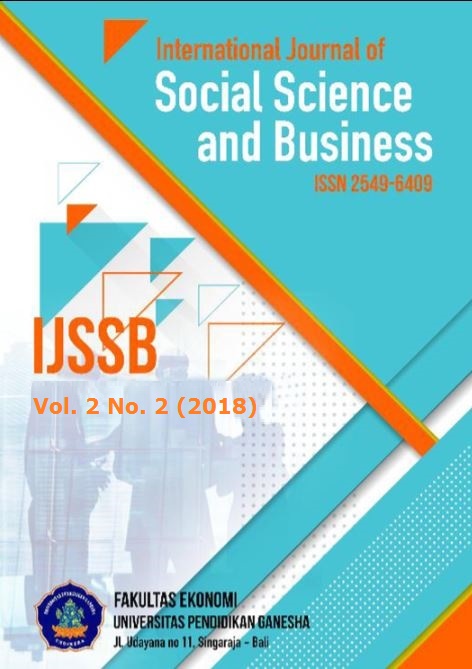Measuring How Destination Image and Perceive Value Affect Customers’ Satisfaction for Ecotourism
DOI:
https://doi.org/10.23887/ijssb.v2i2.13987Keywords:
Destination Image, Perceive Value, Customer Satisfaction, EcotourismAbstract
This study purpose is to determine the effect of destination image and perceived value on the satisfaction’s level of the tourists who visit ecotourism attractions. There are two studies conducted in this research, the first is to validate the effect of destination image to the customers' satisfaction level and also to see the dominant effect of each indicator from the destination image to Customer Satisfaction level. Subsequent study validates the effect of Perceived Value on the customers' satisfaction level as well as to see the dominant indicator of Perceived Value on the customers' satisfaction levels. The study population is the foreign tourists who visited Taman Ayun Pura Mengwi Badung tourist object of Bali. The samples size is set at 65 people. Respondents were selected based on convenience sampling technique from the tourists who already know that Taman Ayun Temple is an ecotourism attraction and received appreciation as world cultural heritage. The data is processed and analysed using SEM through PLS software. The results show that Destination Image and Perceived Value have a positive and significant effect on the Customers' Satisfaction. Perceived Value has a higher correlation coefficient value when it is compared to the Destination Image on the Customers' Satisfaction. This indicates that the managers of tourist object and travel should pay attention on the price paid by the tourists with acceptable or perceived benefits. Other indicators in Perceived Value that should be the evaluation's material is Functional Value and Emotional Value. This indicates that tourists who visit the tourist object pay attention to the service standard received and the pleasure feelings they obtained when they are traveling can increase the tourists' satisfaction.References
Baloglu, S., & McCleary, K. W. (1999). A model of destination image formation. Annals of Tourism Research, 26(4), 868–897.
Bigne, J., Sanchez, M., & Sanchez, J. (2001). Tourism image, evaluation variables and after urchase behavior: Inter-relationships. Tourism Management, 22(6), 607–616. Caruana, A., Money, A. H., & Berthon, P. R. (2000).
Service quality and satisfaction: The moderating role of value. European Journal of Marketing, 34(11/12), 1338–1352. E.
Cruz Ruiz, G. Bermúdez González, D. Tous Zamora, Tourism & Management Studies, 14(1), 2018, 58-68 Fakeye, P., & Crompton, J. (1991).
Image differences between prospective, first-time, and repeat visitors to the lower Rio Grande valley. Journal of Travel Research, 30(2), 10–16.
Fornell, C., 1992. A national customer satisfaction barometer: the Swedish experience. Journal of Marketing 55, 1–21.
Gronroos, C., 1997. Value-driven relational marketing: from products to resources and competencies. Journal of Marketing Management 13, 407–419.
J. JOSEPH CRONIN, JR.MICHAEL K. BRADY, G. TOMAS M. HULT. (2000).Assessing the Effects of Quality, Value, and Customer Satisfaction on Consumer Behavioral Intentions in Service Environments. Journal of Retailing, Volume 76(2) pp. 193–218, ISSN: 0022-4359
Kyung-Hee Kim & Duk-Byeong Park, 2016. Relationships Among Perceived Value, Satisfaction, and Loyalty: Community-Based Ecotourism in Korea
Lee, C., Lee, Y., & Lee, B. (2005). Korea’s destination image formed by the 2002 world cup. Annals of Tourism Research, 32(4), 839–858.
Lovelock, C.H., 2000. Service Marketing, fourth ed. Prentice Hall International.
Oh, H., 2000. Diner’s perceptions of quality, value and satisfaction. Cornell Hotel and Restaurant Administration Quality 41 (3), 58–66.
Petrick, J. F. (2004). The roles of quality, perceived value and satisfaction in predicting cruise passengers’ behavioral intentions. Journal of Travel Research, 42(4), 397–407.
Williams, C., & Buswell, J. (2003). Service quality in leisure and tourism. UK: CABI Publishing.
Zeithaml, V. A. (1988). Consumer perceptions of price, quality and value: A means-end model and synthesis of evidence. Journal of Marketing, 52(July), 2–22.
Zeithaml, V.A., 1988. Consumer perceptions of price, quality and value: a means-end model and synthesis of evidence. Journal of Marketing 52 (July), 2–22.











